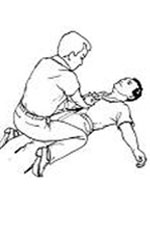What to Do
Talk with the Doctor
If you believe the person you care for has dysphagia, talk to their doctor. When the person has dysphagia, the doctor will refer the person to a dietitian or a speech pathologist. A dietitian is trained to identify people at risk for swallowing problems. Once the problem is identified, the dietitian will be able to pick the best type of diet with the proper food and liquid thickness. A speech pathologist will evaluate swallowing abilities and aspiration risk.
Special Diets
There are many kinds of dysphagia diets, but do not choose one on your own. Let a dietitian be your guide. The dietitian will decide how to change food thickness and liquid consistency so that a diet best matches a person’s limitations. Some people do best with semisolid foods that are easy to chew. Others may need liquid or pureed (pudding like) foods, especially if they have had mouth surgery or have mouth conditions associated with side effects from cancer treatment. Often you will have to thicken liquids with commercial thickeners to decrease the time it takes to move liquid to the back of the throat for swallowing.
Eating Tips
When a person has difficulty swallowing, have him or her follow these tips during a meal:
- Give the person plenty of time to eat
- Have the person brush their teeth and rinse the mouth thoroughly before eating.
- If the person wears dentures, be sure they are thoroughly cleaned, rinsed and placed properly in the mouth.
- Have the person eat small pieces of food (1/2 teaspoon). Break apart or cut up any foods that are hard to chew.
- Alternating a small bite of food, and a sip of liquid may help clear food from the mouth.
- Liquids should be sipped, not gulped. Do Not use straws with persons who have dsyphagia. A straw puts too much liquid in the back of the throat too fast.
- Sucking on lemon ice or sipping lemon water will increase the flow of saliva.
- Do not drink from a can.
- Do not encourage the person to talk while eating. It is better for you to watch and observe and avoid talking
- Have the person eat sitting upright, using the chin tuck position. Raising the chin increases the risk of aspiration.
- Have the person sit upright after each meal (at least 30 minutes) to prevent foods or liquids from coming up into the esophagus.
If a Person Chokes While Eating
If a person begins to choke while eating be sure that he or she sits up straight. If a person can speak, the choking is not life threatening. Have him or her spit out or remove any food or liquids in their mouth and wait till the choking stops. Do not force a person to eat or drink while choking. In some cases you might care for a person who uses oral suction routinely. Oral suction is a good way to remove secretions (See our future lesson on Suctioning the Mouth).

Heimlich Maneuver - If the person choking cannot speak, cough, or breathe, call 911 immediately. While waiting for emergency personnel, stay calm and perform the Heimlich Maneuver (Hīm' lik mah-new-ver). See our lesson on Feeding a Person.
- Stand or kneel behind the person. Wrap your arms around his or her waist. If the person is standing, place one of your legs between his or her legs so you can support the person if he or she faints.
- Make a fist with one hand. Place the thumb side of your fist against the person's belly, just above the belly button but well below the breastbone.
- Grasp your fist with the other hand. Give a quick upward thrust up into the belly. This may cause the food to pop out. You may need to use more force for a large person and less for a child or small adult.
- Repeat thrusts until the object pops out or the person faints.
If you cannot reach around the person, call 911 and do the following:
- Ease the person to the floor and place them on their back.
- Facing the person, kneel astride the victim's hips.
- With one of your hands on top of the other, place the heel of your bottom hand on the upper abdomen below the rib cage and above the belly button.
- Use your body weight to press into the victim's upper abdomen with a quick upward thrust.
- Repeat until object is expelled.
If the person stops breathing and loses their heartbeat (pulse), CPR may be necessary. Do not do CPR on someone if you have not been trained.